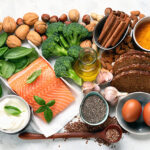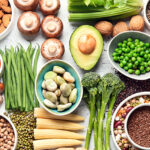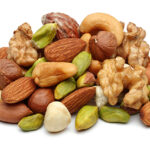News Briefs
Eco-Atkins diet: good for you and good for the environment
Prof. David Jenkins, the father of the glycemic index, wondered what would happen if you swapped the butter, eggs, cheese and meat in the Atkins diet for soy and other vegetable protein foods including gluten and vegetable fats, nuts, avocado, olive and canola oil. In effect exchanging saturated fat and animal protein for healthy monounsaturated and polyunsaturated fats and vegetable protein.
![[PIC]](https://glycemicindex.com/blog/2008/june2008/jenkins110.jpg)
Prof David Jenkins
The University of Toronto Eco-Atkins study of 44 overweight people with a high blood cholesterol level was initially conducted for four weeks with all food provided. Half the participants followed the Eco-Atkins (low carb vegan) diet, comprising 43% fat and 30% protein, with the remainder eating a low-fat NCEP vegetarian diet (25% energy as fat; 16% as protein) to compare the effects of different levels of protein and fat from plant foods. All the dieters lost around 4 kg (nearly 9 pounds), but those on the Eco-Atkins diet also reduced their ‘bad’ LDL cholesterol by around 20% compared with the low-fat dieters whose cholesterol dropped by around 10%.
After careful instruction, 23 of the dieters continued their eating plans for a further six months doing their own meal prep. Those on the Eco-Atkins diet lost a further 2 kg (around 4 1/2 pounds) and their LDL cholesterol stayed 5–6% below what’s called baseline (what it was at the starting point).
Prof. Jenkins said that while the Eco-Atkins diet may not be everyone’s cup of tea it also offers many environmental advantages compared to popular high protein diets where up to 1 kg of meat can be eaten each week. ‘Even if meat-rich diets were healthy and health professionals didn’t have concerns about a potentially increased risk of bowel cancer, it would not be possible to feed a large proportion of our planet on such a diet.’
Talking to GI News, dietitian Sue Radd says: ‘What the Eco-Atkins diet shows is that just as not all carbohydrates are equal, neither is all protein – and plant protein has the added benefit of lowering LDL cholesterol and improving insulin resistance more. The 150 g of protein in the Eco-Atkins diet was from a mix of soy foods, gluten (seitan) and nuts. If you don’t fancy gluten (available canned or chilled from Asian stores) or eating lots of soy foods, try other legumes such as chickpeas, lentils and beans and more nuts and seeds.’
The study has not yet been published, but the findings were presented at the 5th International Congress on Vegetarian Nutrition in California in March 2008. For more details check out the study protocol.
Will a low GI diet help prevent gestational diabetes?
The jury is still out according to the latest issue of The Cochrane Library, calling for further large studies with longer follow-up. Lead review author Joanna Tieu, at the Women and Children’s Hospital at the University of Adelaide said: ‘While our results were promising, the evidence is not sufficient to recommend changes in clinical practices, because of the limited number of trials. [The three eligible studies included only 107 women.] Our results suggest that a low GI diet may be a benefit to mother and child, however. This is because low GI diets such as fresh fruits and vegetables and unprocessed wholegrain foods tend to slow down the digestion of food. Slow digestion allows the body to better adjust to the load of glucose coming in after a meal.’
Gestational diabetes affects an estimated 4% of pregnant women in the US, UK and Australia, and up to 14% worldwide. No one knows exactly what causes it, possibly hormones from the placenta block the action of the mother’s insulin. Without enough insulin, glucose cannot enter cells. Instead, it builds up in the bloodstream, causing hyperglycemia. The excess glucose and other nutrients flow through the placenta, causing the baby’s insulin to rise, thereby encouraging faster growth. This produces significant problems such as a very large baby, an increased risk of the shoulder getting stuck during birth and injury to the mother during birth. There is also increased risks of an induced birth or caesarian birth. ‘Gestational diabetes also has been associated with spontaneous labor and premature birth,’ Tieu said. ‘And children of women with gestational diabetes are at increased risk of obesity, glucose intolerance and diabetes in late adolescence and young adulthood.’
For more information, check out the Intervention Review Abstract.
![[PREGNANT]](https://glycemicindex.com/blog/2008/june2008/pregnant225.jpg)
Low GI carbs benefit young people with type 1 diabetes
For children and teenagers with type 1 diabetes, it is absolutely essential to do everything possible to achieve and maintain optimal blood glucose levels. Poorly managed blood glucose levels, can mean kids don’t reach their full growth potential – this isn’t an area where you get the chance to ‘backspace’ and try again.
Carb counting has been the key dietary strategy to maintain optimal blood glucose levels and reduce the risk of complications. A new study from the University of Newcastle and John Hunter Children’s Hospital has found that swapping high GI for low GI carbs brings additional benefits for children and adolescents with type 1 diabetes on multiple daily injections. In the randomized study, 20 young people aged 8 to 17 with type 1 diabetes ate high GI (84) and low GI (48) pre-made test meals for breakfast containing 60 g carbs (4 exchanges). Each child’s insulin dose was standardized and continuous glucose monitoring was used to assess changes. The low GI meal produced a significantly lower postmeal glucose response for 30–180 minutes compared with the high GI meal. The researchers also investigated insulin timing for a low GI meal and found ultra short acting insulin given before the meal remained the optimal insulin therapy.
What does this mean for young people and their families with diabetes? ‘Our study clearly showed that carbohydrate type as well as carbohydrate amount has an effect on blood glucose control after meals in children with diabetes. This was demonstrated in children on 4 injections per day who had already been taught carbohydrate counting. Substituting healthy low GI foods for high GI choices helps reduce post meal hyperglycemia and is good for the whole family. In addition, young people with diabetes should try to always inject before they eat as this assists blood glucose control,’ says study co-author and dietitian Carmel Smart
– Diabetes Care published ahead of print online May 5, 2008
For more information contact: carmel.smart@hnehealth.nsw.gov.au
![[CARMEL]](https://glycemicindex.com/blog/2008/june2008/carmel125.jpg)
Carmel Smart
What’s new?
The Fertility Diet by Dr Jorge Chavarro, Prof Walter Willet and Patrick Skerrett (published by McGraw Hill)
Infertility affects one in six couples. There are various reasons – a structural problem like blocked fallopian tubes, or a disease of the uterus like fibroids or endometriosis. Many cases (18–30%), though, are due to a failure of ovulation – eggs just don’t ripen and release when they’re supposed to. IVF is an option, but it’s time consuming, expensive, invasive and has a high failure rate. A simpler solution may be a ‘fertility diet’ aimed at increasing certain micronutrients and improving insulin sensitivity through diet (including low GI carbs), weight control and increased physical activity. We reported on this research from Harvard in January 2008 GI News. Here’s the book that discusses the research in detail and provides natural ways to boost ovulation and chances of getting pregnant.
![[SPERM]](https://glycemicindex.com/blog/2008/june2008/sperm200.jpg)
www.eatgoodcarbs.com
For the past fifteen years, American registered dietitian Johanna Burani has been counseling people and writing about how to incorporate low GI carbohydrate choices into balanced meals and snacks. Her new website shares her acquired knowledge and skills. Check it out: www.eatgoodcarbs.com
Who has taught you most about food and cooking?
It’s Australian Food Media Awards time. This year they have widened the field to give home foodies in Australia the chance to take part in the inaugural People’s Choice Award. You can vote for one of the listed nominees: Margaret Fulton, Di Holuigue, Lyndey Milan, Ian “Herbie” Hemphill, Bill Granger, Stephanie Alexander, Maggie Beer and Joanna Savill. Or for your mother. All you need to do to cast your vote is go to the Food Media Club Australia website www.foodmediaclub.com.au and follow the Australian Food Media Awards prompts. Nominations close 31 July 2008.
![[COOKING]](https://glycemicindex.com/blog/2008/june2008/stirfry250.jpg)







